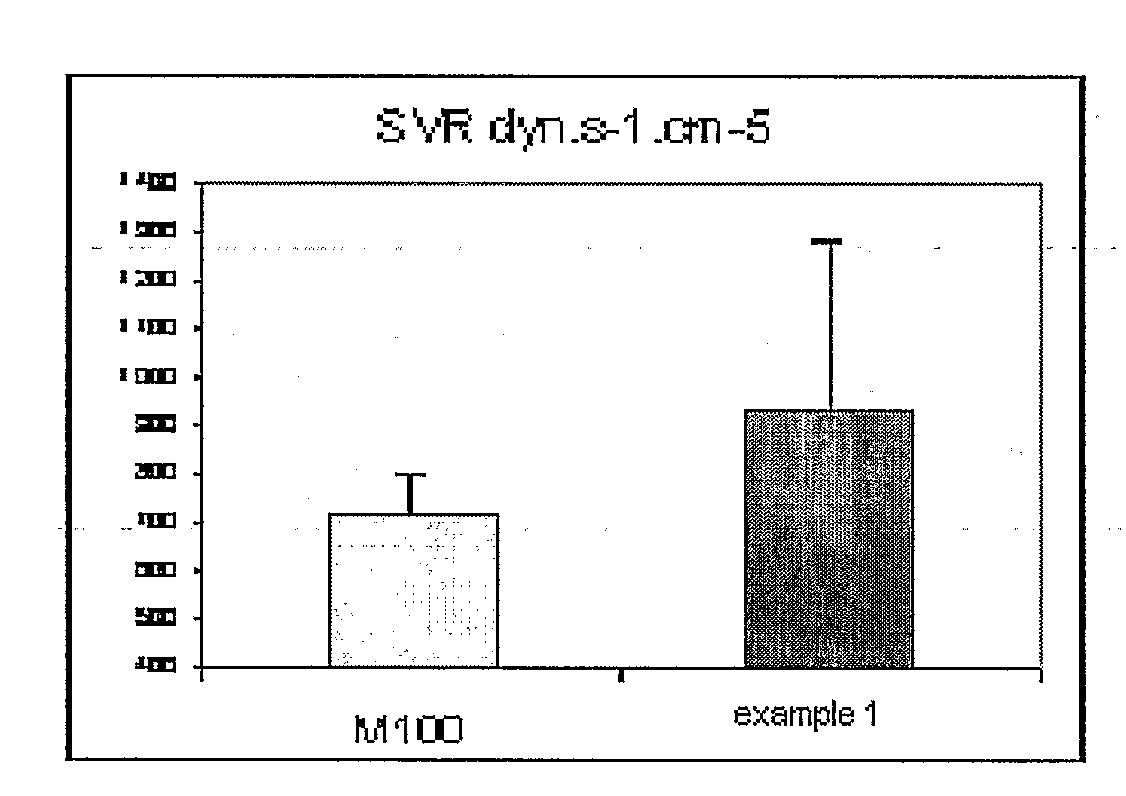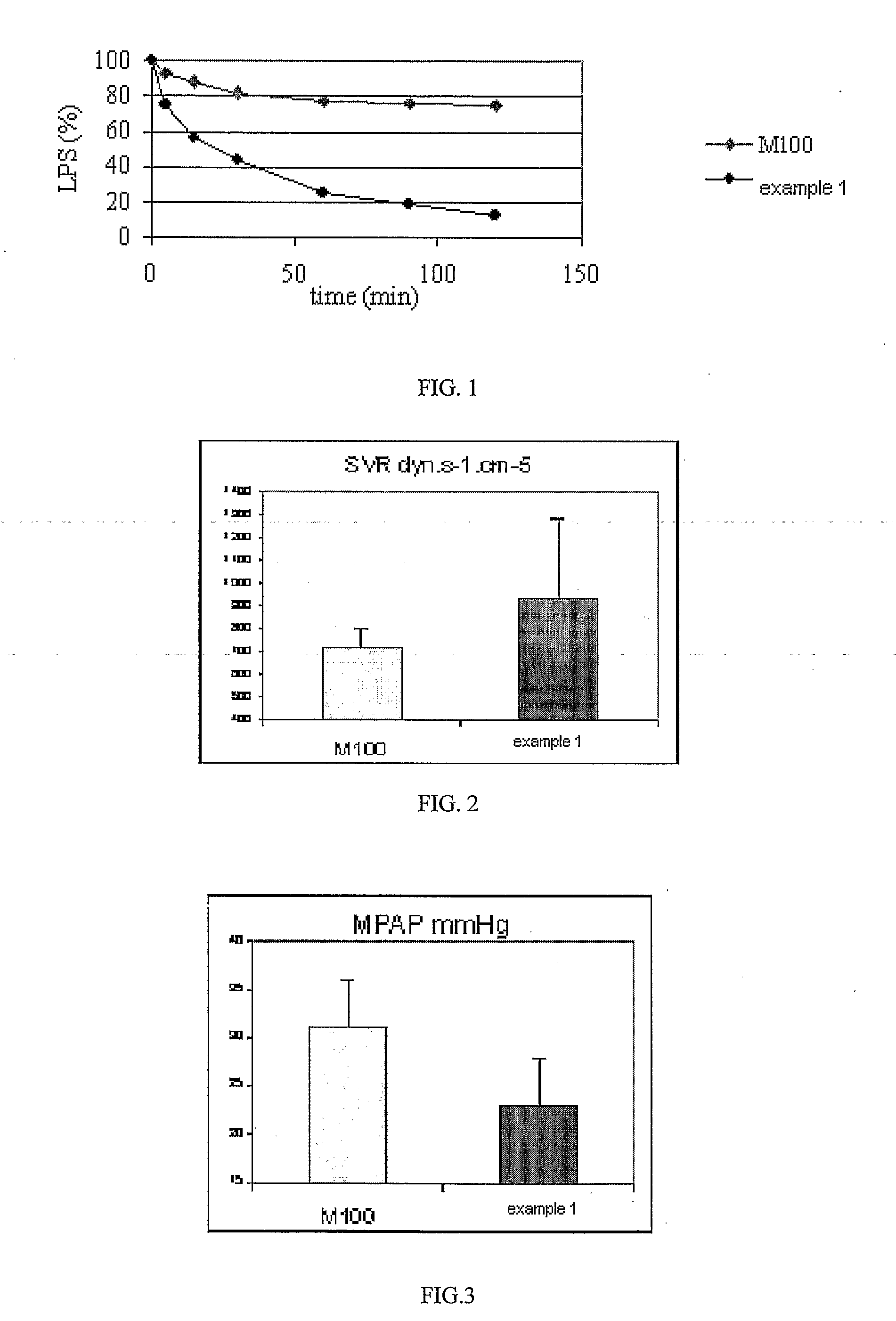Use of a colloidal suspension of a cationic polymer to treat a support for medical use
a cationic polymer and colloidal suspension technology, applied in the field of medical use supports, can solve the problems of unsatisfactory contact phase activation, poor prognosis of mvd accompanied by divc, and limitations in technique, and achieve the effect of reducing mortality
- Summary
- Abstract
- Description
- Claims
- Application Information
AI Technical Summary
Benefits of technology
Problems solved by technology
Method used
Image
Examples
example 1
Manufacture of Product of Example 1
[0253]1. Preparation of a solution 1 containing:[0254]high molecular mass polyethyleneimine (PEI), 1 g / l;[0255]citric acid, 1 g / l;[0256]solvent: water.
[0257]The solution was in the colloidal form.
[0258]See FR-B-2 804 328 in particular for the preparation and characterization of this PEI. Said method for preparing a cationic polymer, in this case a polyethyleneimine (PEI), aiming at eliminating, by fractionation, the smallest chains of polymers (with a low steric hindrance) which may penetrate into the pores of the semi-permeable membrane to be treated and traverse it. FIG. 8 shows the procedure for preparing PEI which comprises the following steps: a-preparation, in a tank 1, of a solution of 1.5 litres of a solution of PEI with a mass average molecular mass of 750 kdalton (LUPASOL P from BASF), 50 g per litre, in distilled water; b-circulation, in a closed circuit, of said solution in the blood compartment of a dialyzer 2 with hollow fibres (trade...
example 2
Manufacture of Product of Example 2
[0287]1. Preparation of a solution 1 containing:[0288]polyethyleneimine with a high molecular mass (PEI) 0.2 g / l. For the preparation and characterization of this PEI, see FR-A-2 804 328 and the description in Example 1 of the present application;[0289]citric acid, 0.2 g / l;[0290]solvent: water.
[0291]The solution was in the colloidal form.[0292]2. Preparation of a solution 2 containing:[0293]non fractionated heparin in a concentration of 100 IU / ml (IU=anti Xa activity);[0294]solvent: water.[0295]3. Surface treatment: a hollow fibre type exchanger with a useful surface of 1.5 m (Multiflow 150, M150) was treated as follows:[0296]circulation of water in the internal (blood) and external (dialysate) compartments at a flow rate of 150 ml / min for 5 min (deglycerination);[0297]circulation of solution 1 in the internal (blood) and external (dialysate) compartments;[0298]flow rate 300 ml / min, 2.5 min in direction 1;[0299]flow rate 300 ml / min, 2.5 min in dire...
example 3
Results of
[0331]
Adsorption of endotoxinsEU / m2Reference, Multiflow 150Example 37380
[0332]It will be observed that the endotoxin adsorption capacity for Example 3 is much higher than that of the reference product which was not treated in accordance with the invention, and also higher than that of Example 2 as more PEI had been adsorbed.
[0333]As will be observed in FIG. 9, an exchanger in accordance with the present invention comprises a semi-permeable membrane such as a bundle of hollow fibres (1) which is disposed in a tubular housing (2) in which it is secured at its two ends by partition in the form of a disk (3, 4). In addition to the fact that the fibres are bonded to each other, the disks act to define in the tubular housing (2) a sealed compartment to which two connectors (5, 6) perpendicular to the axis of the housing (2) provide access. A cap (7, 8) is fixed at each end of the housing (2), said cap comprising an 8 axial access connector (9, 10). The two connectors (9, 10) are...
PUM
| Property | Measurement | Unit |
|---|---|---|
| adsorption capacity | aaaaa | aaaaa |
| flow rate | aaaaa | aaaaa |
| size | aaaaa | aaaaa |
Abstract
Description
Claims
Application Information
 Login to View More
Login to View More - R&D
- Intellectual Property
- Life Sciences
- Materials
- Tech Scout
- Unparalleled Data Quality
- Higher Quality Content
- 60% Fewer Hallucinations
Browse by: Latest US Patents, China's latest patents, Technical Efficacy Thesaurus, Application Domain, Technology Topic, Popular Technical Reports.
© 2025 PatSnap. All rights reserved.Legal|Privacy policy|Modern Slavery Act Transparency Statement|Sitemap|About US| Contact US: help@patsnap.com



